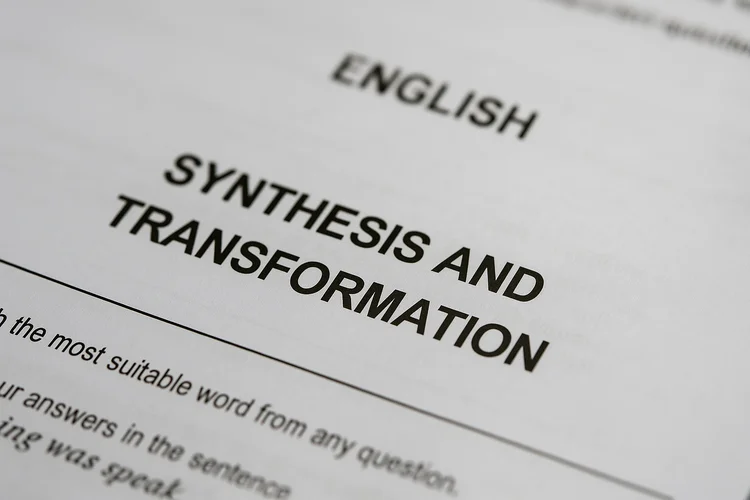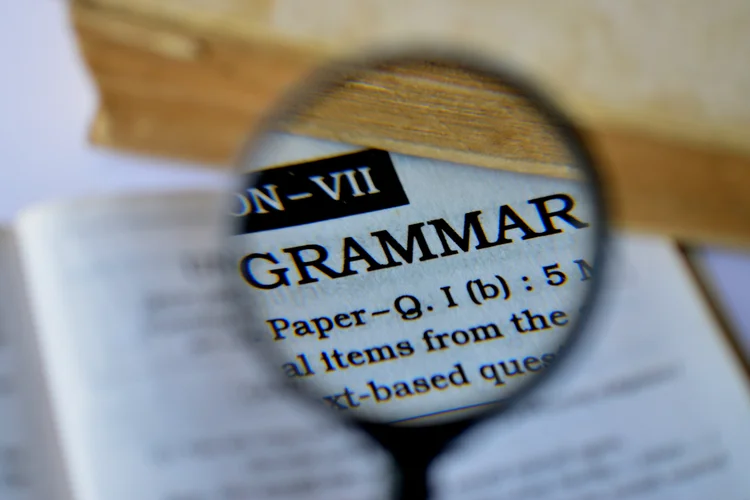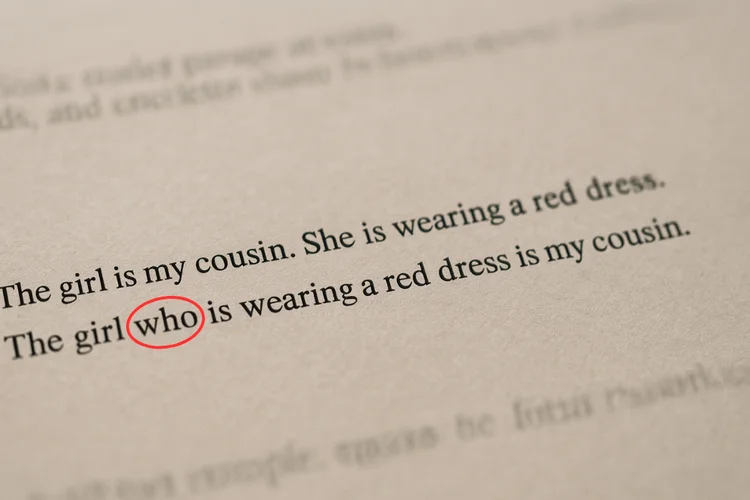What Is Synthesis and Transformation?
Synthesis and transformation is an important part of English grammar where two
or more sentences are combined or rewritten as one without changing the original
meaning. It is part of the PSLE English paper and tests your
understanding of sentence structure, grammar rules, and vocabulary use.
To do well, you need to practise different types of sentences, learn common
transformation patterns, and check your answers carefully to make sure the meaning
stays the same.
In this guide, we’ll explain what the synthesis and transformation section involves
and how you can approach it with confidence.

PSLE Synthesis and Transformation Format
Synthesis and transformation is a 10 mark section found in Booklet B of Paper 2: Language Use and
Comprehension, which carries a total of 90 marks. This section
consists of 5 open-ended questions, each worth 2 marks.
For each question, you are required to combine or transform two sentences into one without
changing the original meaning.
Each answer must be entirely correct to receive full marks. There are no partial marks.
What Does Synthesis and Transformation Assess?
This section tests how well Primary 6 students can:
- Use correct grammar, punctuation, and sentence structure
-
Apply grammar rules, such as:
- Joining sentences with words like "and", "because", or "although"
- Using relative pronouns like "who", "which", or "that"
- Writing if-conditional sentences
- Changing direct speech to reported speech
- Changing active voice to passive voice, or the other way around
- Changing a question tag into a statement

Common Types of Synthesis and Transformation Questions
The most common types of synthesis and transformation questions include:
| Question Type | What It Tests | Example |
|---|---|---|
| Combining with Conjunctions | Joining two sentences using conjunctions such as ‘and, but, because, although.’ |
Original: He is tired. He stayed up late.
Transformed: He is tired because he stayed up late. |
| Using Relative Pronouns | Joining ideas using relative pronouns such as ‘who, which, or that.’ |
Original: The girl is my cousin. She is wearing a red dress.
Transformed: The girl who is wearing a red dress is my cousin. |
| If-Conditionals | Using ‘if’ to show that one action depends on another. |
Original: You do not hurry. You will miss the bus.
Transformed: If you do not hurry, you will miss the bus. |
| Reported Speech | Changing spoken words into a sentence without quotation marks. |
Original: He said, "I am tired."
Transformed: He said that he was tired. |
| Active and Passive Voice | Changing the sentence so the object of the action becomes the subject, usually followed by ‘by’ to show who performed the action. |
Original: The teacher (subject) marked the essays (object).
Transformed: The essays (subject) were marked by the teacher (agent, originally the object). |
| Inversion and Emphasis | Changing the word order to make a sentence sound more formal or more dramatic. |
Original: I have never seen such a beautiful painting.
Transformed: Never have I seen such a beautiful painting. |
Tips to Answer Synthesis and Transformation Questions
Here are some helpful steps you can follow to answer synthesis and transformation questions more accurately:

1. Read Both Sentences Carefully
Start by reading both sentences slowly and clearly.
Try to understand what each sentence is saying. Look out for repeated ideas or words that
are related. This helps you know what parts can be joined or changed.
2. Identify The Type Of Transformation
Think about what kind of grammar change the question is asking for so you know what rule to apply. Here’s what to look out for:
| Type | What to Look Out for | What to Apply |
|---|---|---|
| Conjunctions |
Two sentences showing cause and effect, contrast, or addition.
Example: She was late. She missed the bus. |
Use conjunctions like because, although, but, or and.
Transformed: She was late because she missed the bus. |
| Relative Clauses |
Two sentences about the same person or thing.
Example: The man is my uncle. He is a teacher. |
Use relative pronouns like who, which, or that.
Transformed: The man who is a teacher is my uncle. |
| Reported Speech |
Sentences with a reporting verb (said, told, or asked) followed by direct
speech with quotation marks.
Example: James said, “I am tired.” |
Remove quotation marks (“I am tired” → that he was tired), change
pronouns (I → he), and verb tense (am → was).
Transformed: James said that he was tired. |
| If-Conditionals |
One sentence shows a condition; the other shows the result of that condition.
Example: You do not water the plant. It will die. |
Use if to link both ideas into a conditional sentence.
Transformed: If you do not water the plant, it will die. |
| Active and Passive Voice |
Sentences showing who did the action and what received it.
Example: Sam wrote the essay. |
Change the sentence so the object becomes the subject, or vice versa.
Transformed: The essay was written by Sam. |
| Inversion and Emphasis |
Sentences that begin with never, rarely, little, or that need emphasis.
Example: I had never seen such a mess. |
Change the word order to highlight the idea.
Transformed: Never had I seen such a mess. |
3. Check For Grammatical Accuracy
After writing your sentence, check your grammar. Make sure:
- The tense is correct (e.g. was instead of is; went instead of go)
- The subject and verb agree (e.g. She plays, not She play; They were, not They was)
- You use the right punctuation, like commas and full stops
4. Compare With The Original Meaning
Read your new sentence and compare it to the two original ones. Ask yourself:
- Did I keep the meaning the same?
- Did I miss out on any important information?
If the new sentence means the same and is grammatically correct, you’re good to go!
Synthesis and Transformation Practice Questions
Here are some synthesis and transformation practice questions for you to try:
| Question | Keyword & Blanks |
|---|---|
| 1. She was crying. She lost her toy. | _______________ because _______________. |
| 2. The man is a doctor. He treated my grandmother. | _______________ who _______________. |
| 3. Keith said, “I am not feeling well.” | _______________ that _______________. |
| 4. He did not study. He failed the test. | _______________ because _______________. |
| 5. My mother baked the cake. | _______________ by _______________. |
| 6. Tom said, “I will be home by 6pm.” | _______________ that _______________. |
| 7. You do not follow the rules. You will get into trouble. | If _______________ , _______________. |
| 8. He is my classmate. He won the writing competition. | _______________ who _______________. |
| 9. The teacher sent the letter. | _______________ by _______________. |
| 10. He shouted at me. He was very angry. | _______________ because _______________. |
| 11. Ali said, “I cannot attend the class.” | _______________ that _______________. |
| 12. Sam is not going to the party. The girls are not going too. | _______________ nor _______________. |
| 13. You will not improve. You must practise regularly. | Unless _______________ , _______________. |
| 14. Jane was very tired. She continued working. | Despite _______________ , _______________. |
| 15. I had never heard such a strange story. | Never _______________. |
Suggested Answers:
- She was crying because she lost her toy. (Conjunctions)
- The man who treated my grandmother is a doctor. (Relative Clauses)
- Keith said that he was not feeling well. (Reported Speech)
- He failed the test because he did not study. (Conjunctions)
- The cake was baked by my mother. (Active and Passive Voice)
- Tom said that he would be home by 6pm. (Reported Speech)
- If you do not follow the rules, you will get into trouble. (If-Conditionals)
- The boy who won the writing competition is my classmate. (Relative Clauses)
- The letter was sent by the teacher. (Active and Passive Voice)
- He shouted at me because he was very angry. (Conjunctions)
- Ali said that he could not attend the class. (Reported Speech)
- Neither Sam nor the girls are going to the party. (Conjunctions)
- Unless you practise regularly, you will not improve. (If-Conditionals)
- Despite being very tired, Jane continued working. (Conjunctions)
- Never had I heard such a strange story. (Inversion and Emphasis)
English and Future Success
Research shows that strong English skills go far beyond the classroom, playing a key role in
university1 and career success2. Better English proficiency is not just about grammar and
vocabulary; it provides a crucial stepping stone for achieving life goals.
At Creative Campus, we believe that nurturing strong English skills lays the groundwork for your child’s future success. Our rigorously developed in-house curriculum not only seeks to enhance language proficiency but also fosters critical thinking, creativity, and confidence. Through engaging lessons and dedicated guidance, we equip students with the tools they need to excel academically and beyond. Ready to unlock your child’s full potential? Contact us today to book a trial class and see how we can make a difference!

About Mrs Elizabeth Yeo

CHIEF OPERATING OFFICER
CHIEF FINANCIAL OFFICER
DIRECTOR OF PROGRAMME (PRIMARY LEVELS)
Frequently Asked Questions (FAQ)
To do well in PSLE synthesis and transformation, you need to know key grammar rules, practise often, and pay close attention to meaning. Start by reading both sentences carefully, then identify how they are related and choose the correct grammar structure to join or change them. Make sure your answer is grammatically accurate and still keeps the same meaning as the original sentences.
Synthesis of sentences means joining two or more ideas into one sentence using connecting words, also called conjunctions, like and, because, or who. Transformation of sentences means changing the form of a sentence, such as from active voice to passive voice, without changing its meaning. Synthesis helps you combine ideas clearly, while transformation helps you rewrite a sentence using a different grammar structure. Both require you to follow grammar rules carefully.
A synthesis example is: “He is tired. He stayed up late.” becomes “He is tired because he stayed up late.” This sentence combines two related ideas using the conjunction because. The meaning stays the same, but the ideas are expressed more smoothly in one sentence. Synthesis often uses connectors like and, but, because, or relative pronouns like who, which, or that to join ideas effectively.
You can improve your synthesis skills by practising sentence combination exercises, learning common grammar patterns, and reviewing model answers. Focus on understanding how ideas are logically connected and choose the right conjunctions (e.g. and, because, although) or structures to join them. Reading widely and analysing how sentences are formed in well-written texts can also help. Consistent practice with corrections and clear explanations will build accuracy and confidence over time.
More than three types of grammar are tested in PSLE synthesis and transformation. These can include combining sentences with conjunctions, using relative clauses, forming if-conditionals, changing direct speech to reported speech, rewriting active voice to passive voice, and applying inversion or emphasis structures.
A simple sentence for synthesis might be: He was tired. He stayed up late. This becomes: He was tired because he stayed up late. Another example is: The boy is my brother. He plays the guitar. This becomes: The boy who plays the guitar is my brother. These examples show how two related ideas can be joined using words like because or who, without changing the meaning.
